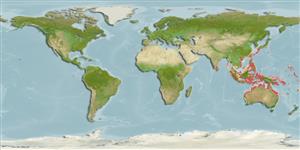Environment: milieu / climate zone / depth range / distribution range
Ecologia
marinhas; estuarina associadas(os) a recifes; intervalo de profundidade 1 - 12 m (Ref. 90102). Tropical
Indo-West Pacific: Indo-Australian Archipelago.
Tamanho / Peso / Idade
Maturity: Lm ? range ? - ? cm
Max length : 134 cm TL macho/indeterminado; (Ref. 2334); common length : 40.0 cm TL macho/indeterminado; (Ref. 9801)
Descrição suscinta
Chaves de identificação | Morfologia | Morfometria
Espinhos dorsais (total) : 1; Raios dorsais (total) : 104 - 115; Espinhos anais: 0; Raios anais : 90 - 100. Differs from Paraplotosus butleri in having a shorter dorsal fin and shorter nasal barbels, rounded pectoral fin shape, fewer upper procurrent caudal fin rays, and fewer gill rakers. Differs from P. muelleri in having a shorter dorsal fin and smaller eye (Ref. 31103). Color highly variable, ranging from pale grey or yellowish brown to dark brown, nearly blackish, sometimes with pronounced dark mottling; generally whitish on belly and ventral part of head; fins brown to blackish, frequently darker than body (Ref. 31103).
In tropical areas, inhabits clear and turbid coral reefs; usually found in areas with mixed sand, weed, and coral areas (Ref. 31103). May be seen resting on sand bottoms under ledges or around coral bommies (Ref. 31103). Adults solitarily or in small groups. Presumably nocturnal (Ref. 31103). Feeds on gastropod mollusks and crustaceans (Ref. 31103). Spines associated with anterior fins have potent venom (Ref. 9801).
Ciclo de vida ou comportamento de acasalamento
Maturities | Reprodução | Spawnings | Egg(s) | Fecundities | Larvas
Allen, G.R., 1998. A review of the marine catfish genus Paraplotosus (Plotosidae) with the description of a new species from north-western Australia. Raf. Bull. Zool. 46(1):123-134. (Ref. 31103)
Status na Lista Vermelha da UICN (Ref. 130435)
Uso pelos humanos
Pescarias: pouco comercial
Ferramentas
Relatórios especiais
Baixar XML
Fontes da internet
Estimates based on models
Preferred temperature (Ref.
123201): 24.2 - 29.3, mean 28.5 °C (based on 2310 cells).
Índice de diversidade filogenética (Ref.
82804): PD
50 = 0.6250 [Uniqueness, from 0.5 = low to 2.0 = high].
Bayesian length-weight: a=0.00457 (0.00199 - 0.01049), b=3.07 (2.86 - 3.28), in cm total length, based on LWR estimates for this (Sub)family-body shape (Ref.
93245).
Nível Trófico (Ref.
69278): 3.4 ±0.54 se; based on food items.
Resiliência (Ref.
120179): Baixo, tempo mínimo de duplicação da população 4,5 - 14 anos (Preliminary K or Fecundity.).
Fishing Vulnerability (Ref.
59153): Very high vulnerability (80 of 100).
Nutrients (Ref.
124155): Calcium = 26.6 [11.5, 53.2] mg/100g; Iron = 0.437 [0.248, 0.789] mg/100g; Protein = 17.4 [15.5, 19.6] %; Omega3 = 0.0738 [, ] g/100g; Selenium = 37.8 [19.2, 80.7] μg/100g; VitaminA = 42.4 [14.3, 124.5] μg/100g; Zinc = 1.12 [0.77, 1.59] mg/100g (wet weight); based on
nutrient studies.
